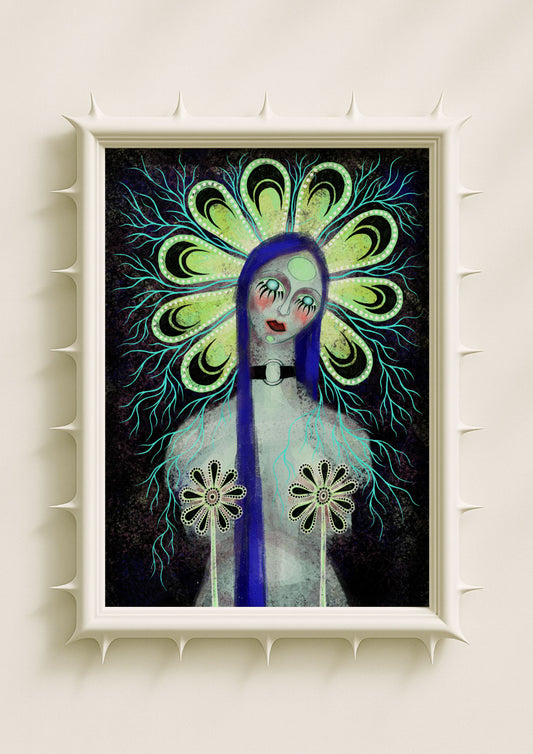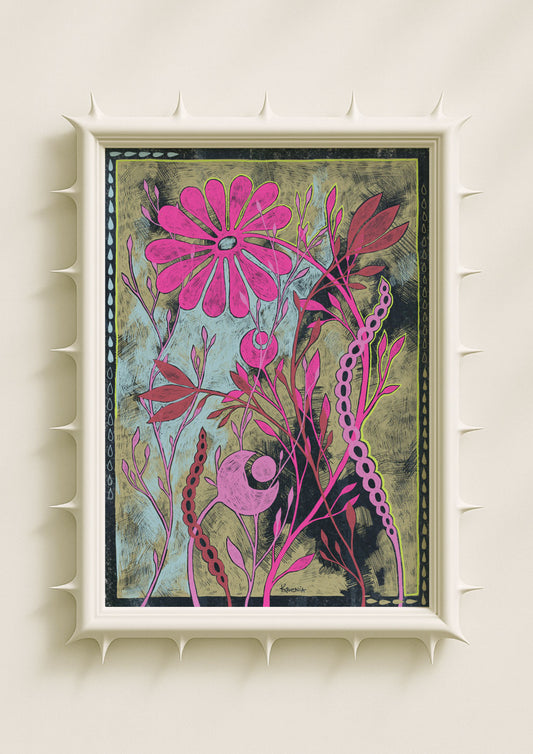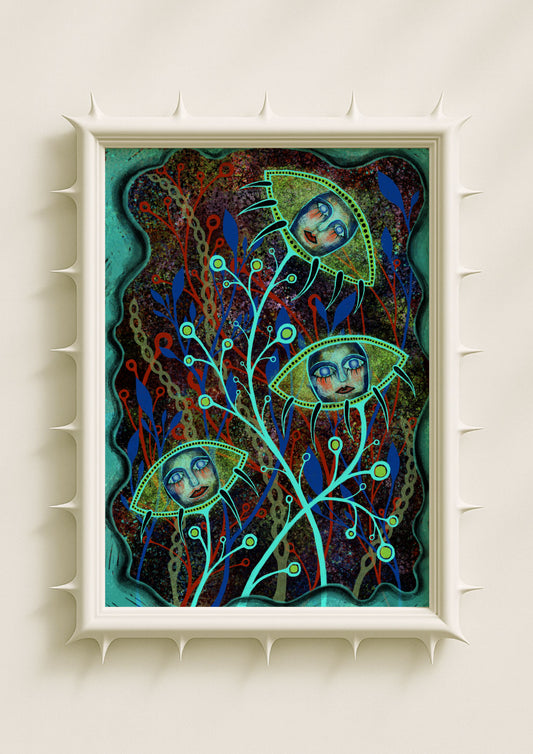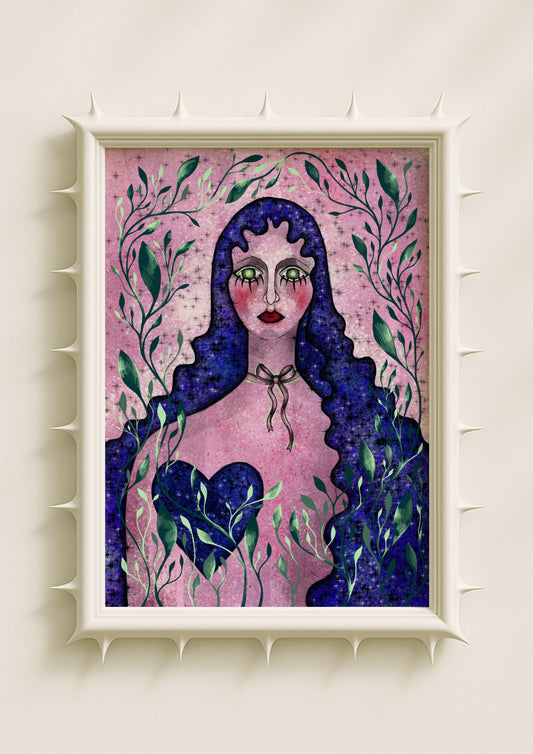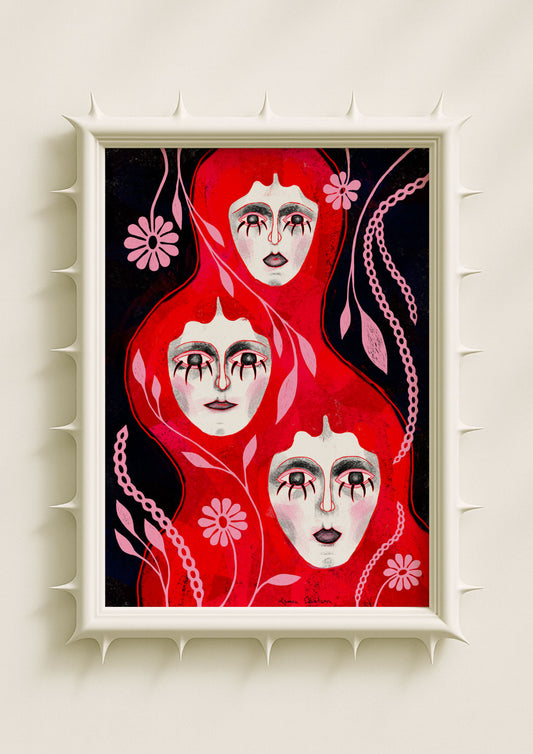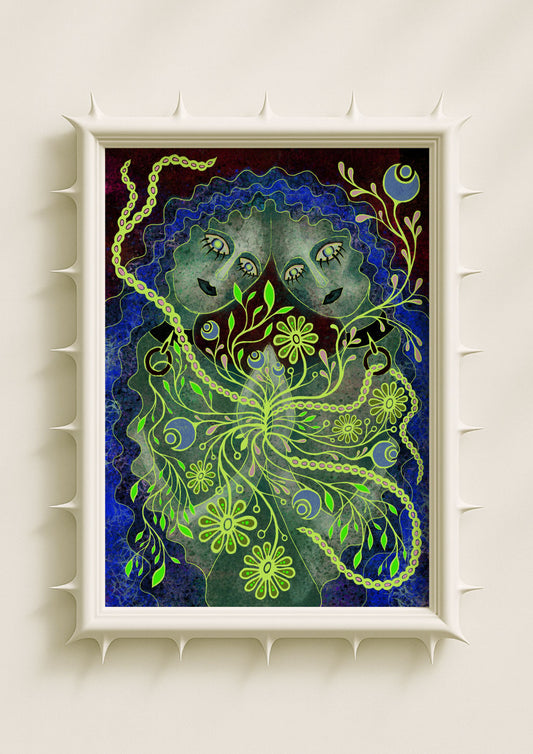When Flora Becomes a Language of the Feminine
In botanical portrait posters, the female face does not stand alone. It is framed, softened, mirrored, or transformed by flowers, vines, petals, and organic shapes that behave like emotional extensions. These botanicals are not decorative elements — they carry meaning. They act as metaphors for desire, cycles, softness, and rebirth, revealing how femininity expresses itself visually through symbols of nature. Seen through the female gaze, flora becomes a vocabulary of inner life, one that blends quiet sensitivity with intuitive strength.

Botanical Desire as Gentle Attraction
When flowers lean toward the face, open softly beside the cheek, or stretch subtly toward the lips, they evoke desire without spectacle. The desire is not objectifying; it is atmospheric. It feels like a pull toward warmth, curiosity, or internal softness. Florals placed close to the face become symbols of attraction that are emotional rather than erotic, tied to presence and attention rather than performance. They express a longing that feels inward, delicate, and grounded in sensitivity.
Growth as a Feminine Inner Process
Botanicals growing from behind the head, spreading across the collarbone, or appearing to bloom from within the figure act as metaphors for internal growth. This growth is rarely linear. Vines twist, petals overlap, branches extend in unexpected directions — mirroring the non-linear path of emotional evolution. In feminine portraiture, botanical growth suggests expansion of self-awareness, the slow unfurling of identity, and the blooming of inner truth. The imagery reflects a kind of becoming that feels both tender and powerful.
Floral Cycles and the Rhythms of Emotion
Flowers carry inherent symbolism of cycles — blooming, fading, returning. In portrait posters, this cyclical language mirrors emotional rhythms: renewal after exhaustion, softness after tension, clarity after uncertainty. A partially wilted bloom next to a fresh bud communicates the coexistence of strength and fragility. A vine looping in a circular motion hints at emotional repetition or the return to a familiar inner landscape. The botanical cycle becomes a reflection of the feminine emotional cycle — shifting, renewing, alive.

Softness as a Visual Form of Power
Botanicals often soften the face, blurring sharp lines or creating gentle shadows. This softness is not weakness; it is a form of emotional truth. Petals, rounded leaves, or airy blooms act like visual carriers of sensitivity. When they frame the face, they create an aura of openness — a reminder that feminine strength often resides in sensitivity, quietness, and emotional depth. The botanicals transform softness into a form of presence, one that holds space rather than demands it.
Rebirth Through Organic Transformation
In many botanical portraits, flowers and organic shapes appear to emerge from the figure, suggesting renewal or a return to self. Rebirth is expressed through blooming forms that replace tension, petals that appear where silence once lived, or vines that weave through the figure like new pathways of awareness. This symbolism echoes the process of emotional rebirth — the subtle restructuring of identity after loss, change, or introspection.
The Female Gaze as a Botanical Lens
What makes these portraits uniquely shaped by the female gaze is the way botanicals are used not to decorate the woman, but to express her interiority. The flora bends toward emotion, not towards beauty standards. It mirrors inner states rather than framing the figure as an object. Through this lens, the face becomes a landscape, and the botanicals become its weather — moving with feeling, revealing mood, shifting with the internal seasons.

Why Botanical Symbolism Resonates with Feminine Identity
Botanical surrealism pairs beautifully with feminine portraiture because both express complexity through gentleness. Flowers and vines offer metaphors that hold contradiction gracefully: beauty and fragility, change and persistence, softness and resilience. In your posters, the botanicals do not simply surround the woman — they express her.
They reveal desire as warmth, growth as introspection, cycles as emotional truth, softness as power, and rebirth as inevitable. Through this symbolic vocabulary, the female gaze becomes not just a way of seeing but a way of understanding the self in full, layered, and ever-blooming form.
